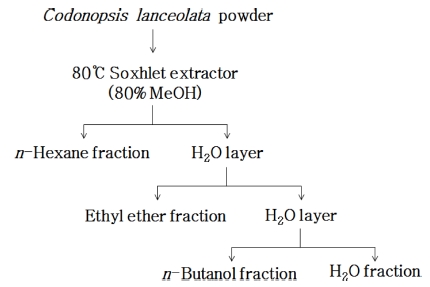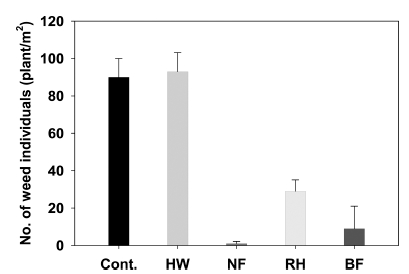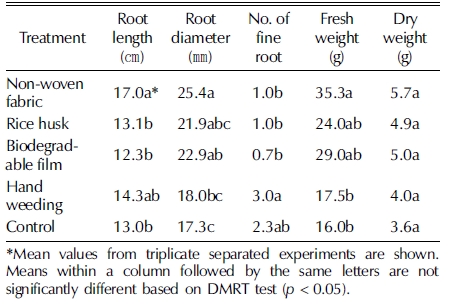
피복물 종류에 따른 더덕의 생육 및 항산화 물질 비교
© The Korean Society of Medicinal Crop Science. All rights reserved.
This is an Open-Access article distributed under the terms of the Creative Commons Attribution Non-Commercial License ( http://creativecommons.org/licenses/by-nc/3.0 ) which permits unrestricted non-commercial use, distribution, and reproduction in any medium, provided the original work is properly cited.
Abstract
This study determined the effects of mulching, an environment friendly organic cultivation method, on antioxidant compound contents and growth in Codonopsis lanceolata, commonly known as Deodeok.
C. lanceolata was treated by mulching with several different methods (a non-woven fabric, biodegradable film, or rice husks) and also treated with hand weeding. A non-treatment plot was used as a control. The growth and levels of weed control in C. lanceolata were better in plants cultivated under mulching treatments (non-woven fabric, biodegradable film, and rice husks) than in those under non-mulching treatments (hand weeding and non-treatment). The contents of antioxidant compounds, such as total flavonoids, phenolics, and anthocyanins, were highest under the biodegradable film treatment, followed by the nonwoven fabric treatment, rice husks treatment hand weeding, and non-treatment. There were identifiable differences in DPPH and ABTS activity in comparison to antioxidant compound content by solvent fractions. Mulching treatments resulted in higher DPPH scavenging activity in water and ethyl ether fractions and ABTS scavenging activity in n-butanol fractions than in other fractions, as opposed to hand weeding and non-treatment groups, although total activity of DPPH and ABTS did not increase with mulching treatments.
Mulching C. lanceolata with biodegradable film and non-woven fabric is an effective method for improving plant growth and inhibiting the occurrence of weeds as well as for increasing antioxidant compound content and altering antioxidant activity.
Keywords:
Antioxidant Activity, Biodegradable Film, Cultivation, Non-Woven Fabric, Saponin서 언
더덕 (Codonopsis lanceolata Trautv.)은 초롱꽃과 다년생 덩굴성 식물로 예로부터 인삼 등과 함께 오삼 중의 하나로 불 리웠고, 천연식품 및 한약재로 널리 이용되어 왔다 (Yoo et al., 2002;Kim and Chung, 1975). 최근에는 건강식품을 선 호하는 현대인의 요구에 적합한 먹거리로 인식되어 더덕에 대 한 수요가 폭발적으로 증가하고 있어 국내 더덕 재배면적도 2013년 7,288톤에서 2014년 8,548톤으로 매년 증가하는 추세 에 있다 (MAFRA, 2015).
더덕의 주요성분은 polyphenol, tannin, alkaloid, steroid, saponin등이 있고 (Lee et al., 2002) 이들은 진해, 거담, 두통 등에 약리작용이 있을 뿐만 아니라 인후염이나 림프절 결핵에 도 효과가 있으며 오랫동안 먹어도 독성이 없는 한약자원으로 알려져 왔다 (Park et al., 2009). 더덕의 사포닌은 lancemaside A, B, C, E, G, foetidissimoside A, aster saponin Hb 등이 주성분으로 보고되어 있으며 (Ichikawa et al., 2009), 그 중 lancemaside A는 대장염을 유발한 쥐의 염증 단백질인 NF-κB 를 억제하여 대장염을 완화시키고 (Joh et al., 2010;Kim et al., 2014a), 기억력 및 불면증 개선에 효과 (Jung et al., 2012)등 다양한 효능이 있는 것으로 알려져 있다.
최근 연구에 의하면 더덕의 부위 중 일반적으로 사용하는 뿌리뿐만 아니라 줄기나 잎에서도 saponin, flavonoid, phenol 성분들이 다량으로 함유되어 있는 것이 보고되기도 하였다 (Kim et al., 2014b;Park, 2014). 더덕에 포함되어진 성분이 가공과정 중 화학적 변화를 일으켜 페놀성 물질이 증가하고 이에 따라 항산화 활성이 높아진다고 하였으며 (Jeon et al., 2013), 포장 및 저장 기간에 따라서도 사포닌 성분이 변화된 다고 보고되고 있다 (Choi et al., 2006). 또한 더덕은 추출방 법 뿐만 산지별로 조직의 원천적인 차이에 기인하여 항산화 활성에 차이가 난다고 하였으며 (Kim et al., 2010) 이러한 결과는 더덕의 재배방법에 따라 더덕의 사포닌 성분이 변화될 수 있음을 시사한다고 하겠다.
더덕을 비롯한 인삼, 잔대 등 뿌리를 약재 또는 식용으로 이용하는 작물들은 장기간 토양 속에서 재배되기 때문에 병충 해 방제를 위해 농약, 제초제, 화학비료 등이 사용되어 왔다. 이로 인한 잔류 농약 문제가 사회적 문제로 대두되면서 많은 소비자들이 약용작물에 대한 안전성에 관심을 기울이고 있다 (Seo et al., 2009). 따라서 더덕은 한약재뿐만 아니라 건강 기 능성 식품으로도 이용되기 때문에 유기질 비료를 이용하거나 제초제 대신 피복물을 이용하는 등의 친환경 유기재배 기술 개발이 요구되고 있는 실정이다. 현재 더덕의 친환경 유기재 배와 관련된 연구는 Chung (1999)이 자생, 관행, 유기재배 등 더덕 재배방법별로 더덕 성분을 분석한 결과 활엽수와 볏짚이 포함된 퇴비를 시용하였을 때 총 아미노산과, 유리 아미노산 이 일반재배에 비해 각각 1.5배, 5배 증가하였다고 하였고, Lee 등 (1996)은 더덕에 차광과 유기물을 처리할 때 지상부 및 지하부 생육은 무차광에서 양호하였으나, 향기성분은 차광 에서 양호하며 유기물 시용이 증가 할수록 방향성이 높아진다 고 하였다. 또한 Lee 등 (1998)은 유기물 종류에 따른 더덕 뿌리의 일반성분과 정유성분의 변화에 대해 연구한 결과 유리 아미노산의 경우 활엽수를 퇴비로 시용하였을 때 증가하고, 정 유성분과 향기성분은 침엽수와 이끼를 퇴비로 시용하였을 때 증가한다고 보고 하였으나 친환경 유기재배와 관련된 연구는 아직 부족한 수준이다.
따라서 본 연구에서는 친환경 유기재배의 한 방법으로 친환 경 피복물을 이용할 경우 잡초발생량 감소 정도와 더덕의 생 육 특성 및 항산화 물질 함량 변화를 조사하고자 수행하였다.
재료 및 방법
1. 재료 및 처리 방법
시험재료로 사용된 더덕 (Codonopsis lanceolata Trautv.)은 2년생 종근을 이용하여 정식하고 피복물 처리를 하였다. 피복 물처리는 검정 부직포 (Black, Sewonfilm, Goryeong, Korea), 생분해성 필름 (Batro, Ihlshin Chemical, Ansan, Korea), 왕 겨 (Rice-husk, Helpfarm, Yeongju, Korea)등을 처리하였고, 무피복 처리로 손제초, 무처리 등 5가지 처리를 단구제로 처 리하여 생육을 관찰 조사하고 추출물 위해 사용된 샘플은 5주 씩 3반복으로 조사하였다.
2. 더덕 추출물 제조 및 유기용매 분획
수확한 더덕은 깨끗이 수세하여 세정 및 세절하여 동결건조 기 (FD8508, Ilshin Biobase, Dongducheon, Korea)로 동결건 조 후 마쇄하여 실험에 이용하였다. 시료 무게 10배에 해당하 는 80% MeOH를 첨가하여 3시간동안 3회 환류 추출하고, 여 과 후 감압 농축 (R-520, Ilsin, Daejeon, Korea)하여 더덕 MeOH 추출물을 얻었다. MeOH 추출물은 Fig. 1의 순서에 따 라 추출액을 증류수로 현탁하여 동량의 n-hexane을 가한 후 30 분간 진탕하여 분획 깔때기로 n-hexane층과 water층을 얻었다. 같은 방법으로 ethyl ether, n-butanol층과 water층을 얻었고, 각 각의 분획물을 rotary evaporator로 농축하여 80% MeOH로 시료 무게의 100배로 희석 한 후 실험에 사용하였다.
3. 생육특성 조사
더덕의 지상부 생육특성 조사는 6월과 10월에 시기별로 2 회 조사하였고, 지하부의 경우도 10월에 1회 조사하였다. 지 하부는 근장, 근경, 세근수, 생체중, 건물중 등을 각각 조사하 였다.
4. 토양 수분지온 및 잡초발생량 조사
토양 수분지온 측정은 정식 후 4월 말부터 6월 중순까지 7일 간격으로 측정하였고, 잡초발생량은 피복 처리 후 70일경 (6월)에 0.25㎡의 Quadrat을 이용하여 발생한 모든 초종의 개 체수를 조사하고 단위면적당 (㎡)으로 환산하여 나타내었다.
5. Total flavonoid 함량 측정
총 플라보노이드 함량은 Shen 등 (2009)의 방법을 변형하여 시료 0.5㎖, 증류수 2㎖, 5% NaNO2 0.15㎖를 잘 혼합하 여 5분간 실온에 둔 후 10% AlCl3H2O 0.15㎖를 첨가하여 5분간 반응시켰다. 그 다음 1M NaOH 1㎖를 첨가하여 잘 혼 합한 후 15분간 반응을 시켜 Spectrophotometer (EZ Read 2000, Biochrom, Cambridge, England)를 이용하여 415㎚에서 흡광도를 측정하였다. 표준물질은 quercetin (Sigma Aldrich, St. Louis, MO, USA)을 사용하여 농도를 계산하였다.
6. Total phenolic compounds 함량 측정
총 페놀화합물 정량은 Arnous 등 (2001)의 방법을 변형하 여 정량하였다. 1.5㎖ effendorf tube에 시료 0.1㎖와 증류수 790㎕, 1 N Folin-Ciocalteu (Sigma Aldrich, St. Louis, MO, USA) 50㎕를 혼합하여 1분간 반응시킨 후, 다시 20% sodium carbonate 150㎕를 첨가하여 120분간 암소에서 반응 시킨 다음 spectrophotometer를 이용하여 750㎚에서 흡광도 를 측정하였다. 표준물질은 gallic acid (Sigma Aldrich, St. Louis, MO, USA)를 이용하여 농도를 계산하였다.
7. Anthocyanin 함량 측정
총 안토시아닌 함량은 Choi 등 (2013a)의 방법을 변형하여, 시료를 96 well plate에 시료용액과 1% HCl이 포함된 MeOH 을 혼합하여 추출한 후 여과지로 여과한 용액을 흡광도 530㎚ 에서 측정하고, 표준물질은 pelargonidin-3-glucoside (Sigma Aldrich, St. Louis, MO, USA)를 이용하여 농도를 계산하였다.
8. DPPH와 ABTS radical 소거활성
DPPH (1,1-diphenyl-2-picrylhydrazyl, Sigma Aldrich, St. Louis, MO, USA) radical 소거활성은 Brand-Williams 등 (1995)의 방법을 변형하여 측정하였다. 80% MeOH에 200μM 농도로 녹인 DPPH 용액 700㎕와 시료 300㎕ 잘 혼합하여 30분간 반응시킨 후, 517㎚에서 흡광도를 측정하고, 아래의 식을 이용하여 항산화 활성을 계산하였다. 대조구로는 Lascorbic acid를 사용하였다.
ABTS (2,2’-azino-bis-3-ethylbenzo-thiazoline-6-sulfonic acid, Sigma Aldrich, St. Louis, MO, USA) radical 소거활성의 측 정은 Jeong 등 (2010)의 방법을 변형하여 2.45mM potassium persulfate와 7mM ABTS를 혼합하여 암소에서 여과 후 30℃, 16 h동안 암소에서 보관하여 사용하였다. ABTS 용액은 실험 직전 734㎚에서 흡광도가 0.7이 되도록 80% MeOH를 이용 하여 희석하였다. 희석된 ABTS 용액 1㎖와 시료 0.1㎖를 잘 혼합하여 water bath에서 37℃로 20분간 반응시킨 후 734㎚에 서 흡광도를 측정하고, DPPH radical 소거활성 공식과 동일한 식을 이용하여 계산하였다. 대조구로 L-ascorbic acid를 사용하 였다.
9. 통계처리
본 연구의 실험 데이터는 처리당 3반복으로 측정하였고, 수 집된 데이터는 SPSS program (SPSS version 21, SPSS Inc., Chicago, IL, USA) 프로그램을 이용하여 일원배치 분산 분석 (one way ANOVA)을 실시한 후, Duncan’s Multiple Range Test (DMRT)을 통해 5% 수준에서 통계학적 유의성을 검정하였다.
결과 및 고찰
1. 피복물 종류에 따른 토양 수분 및 지온 변화 및 생육조사
피복물 종류에 따른 토양의 지온 및 수분함량을 조사한 결 과 (Fig. 2), 조사 기간 동안의 평균 지온은 생분해성 필름 처 리에서 가장 높아 최고온도가 40℃이상 되는 경우도 있었다. 무처리와 손제초처리도 외기온이 오르면 지온도 올라 최고기 온이 35℃이상 되는 경우도 있었다. 반면에 왕겨와 검정 부직 포 처리는 온도가 낮아지는 경향을 나타내었는데, 이것은 외 기온이 올라갈수록 왕겨와 검정 부직포는 차광 역할을 하는 것으로 판단된다 (Fig. 2A). 토양 수분함량은 생분해성 필름 처리에서 가장 높았고 그다음이 부직포, 왕겨 순으로 나타나 피복물 처리들은 토양수분 증발 억제효과도 있는 것으로 나타 났다. 반면 손제초 처리는 토양수분함량이 가장 낮았는데 이 는 제초에 의해 토양이 교반되었기 때문에 수분함량이 가장 낮은 것으로 판단된다 (Fig. 2B).

Change of temperature (A) and moisture contents (B) on soil according to mulching materials in Deodeok (Codonopsis lanceolata) field.NF; Non-woven fabric, RH; Rice husk, BF; Biodegradable film, HW; Hand weeding, Cont.; Control, non-treatment. Data represent of the values of mean (n = 3) with standard error.
지온 및 수분 변화에 따른 더덕 (Codonopsis lanceolata Trautv.)의 지상 및 지하부 생육을 조사한 결과, 지온과 수분 보유력이 높았던 생분해성 필름에서 6월과 10월에 모두 생육 이 가장 왕성하였고, 무처리를 제외한 나머지 처리들은 약간 의 생육 차이는 있었지만 통계적으로 유의적인 차이를 보이지 않았다 (Fig. 3). 지하부에서도 피복물 처리인 생분해성필름, 부직포, 왕겨 처리에서 무피복물 처리인 손제초와 무처리보다 뿌리직경이나 생체중이 일반적으로 높았는데 이러한 생육촉진 효과는 토양수분과 지온이 관련 있는 것으로 판단된다. 건물 중은 피복물 처리에서 다소 높은 경향이었으나 통계적으로 유 의적인 차이는 인정되지 않았다 (Table 1). Park 등 (2004)은 삽주를 투명멀칭처리하면 지온을 상승시켜 초기 생육을 촉진 시키는 효과는 있으나 고온기를 경과하면서 삽주의 생육적온 이상으로 지온이 상승됨으로써 그 효과가 사라진다고 하였는 데, 본 연구에서도 더덕의 초기 생육은 촉진되지만 후기에 고 온에 의해 조직의 치밀도가 낮아 건물중은 처리간 차이가 나 지 않는 것으로 판단된다. Kim 등 (2007)은 강활 재배시 피 복처리를 할 경우 지하부 근경이 같은 P.E피복이라도 흑색 P.E피복이 투명 P.E피복이나 볏짚피복에 비해 굵어지고, 수량 또한 증가한다고 하였고, Cho 등 (2008)은 토양피복 처리에 따른 석창포 생육을 조사한 결과 검정 부직포 피복을 할 경우 가장 양호한 생육을 나타냈다고 보고한 바 있다. 따라서 본 연구에서도 검정 부직포나 생분해성 필름과 같은 피복물 처리 는 지온을 상승시키거나 유지시키고, 토양의 수분증발을 억제 시킴으로써 더덕 뿌리의 생육을 촉진하는 효과가 있는 것으로 나타났고 또한 과도한 지온 상승에 의한 약간의 고온 스트레 스도 있는 것으로 판단된다.
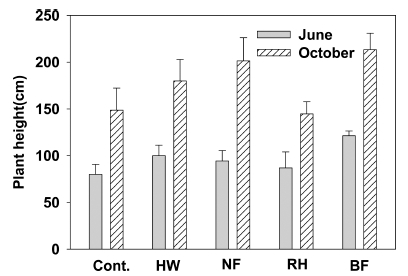
Change of plant height by mulching material on the weed control in Deodeok (Codonopsis lanceolata) cultivation.Cont.; Control, nontreatment, HW; Hand weeding, NF; Non-woven fabric, RH; Rice husk, BF; Biodegradable film. Data represent of the values of mean (n = 3) with standard error.
2. 피복물처리에 따른 잡초발생량
피복물 종류에 따른 잡초 발생량을 조사한 결과 (Fig. 4), 검정 부직포, 생분해성, 왕겨 처리에서는 거의 발생하지 않았 으나, 무처리, 손제초 처리의 경우 잡초 발생량이 매우 높은 것을 확인할 수 있었다. 이것은 Jung 등 (2011)의 안개초 재 배시 토양에 흑색과 녹색 부직포를 전면피복 처리 하였을 때 무처리에 비해 잡초가 거의 발생하지 않았다는 결과와 일치하 였다. 그러나 검정 부직포는 무거워서 피복에 많은 노동력이 소요되며, 생분해성 필름은 값이 비싸고 잘 찢어지며, 왕겨는 부피가 크고 비나 바람에 의한 피복 손실로 인하여 시간이 지 남에 따라 잡초발생량이 증가하는 단점이 있다.
3. 피복물 처리에 따른 항산화 물질 분석
피복물 처리에 따라 80% MeOH 추출물과 4가지 추출용매별 항산화 물질함량을 조사한 결과 (Fig. 5), flavonoid, phenolic compounds, anthocyanin 세 가지 물질 모두 피복물 처리 (생분 해성필름, 부직포, 왕겨)에서 무피복물 처리 (무처리, 손제초) 보 다 높은 함량을 나타내었다. 추출용매별 물질함량을 조사해 보 면 세 가지 항산화 물질 모두 n-butanol 층에서 함량이 가장 높았고, 플라보노이드 (Fig. 5A)와 페놀 화합물 (Fig. 5B)에서 는 n-butanol층 다음으로 ethyl ether 층이 높았다. 반면에 안 토시아닌 함량은 생분해성 필름과 검정 부직포 처리에서 높았 으나 n-butanol층과 MeOH 추출물에서만 검출되었고 나머지 분획층에서는 검출되지 않았다. n-butanol은 n-hexane이나 ethyl ether에 비해 극성이 높아 여러 가지 성분 중에서도 사포 닌이나 배당체, 플라보노이드, 페놀성 물질 등이 많이 분리, 추 출되는 것으로 알려져 있다 (Kim et al., 2003;Lee, 2014). 이에 따라 Kim 등 (2007)은 더덕 메탄올 추출물 분획 중 n-butanol 층을 이용하여 더덕 사포닌의 항산화 활성을 보 고하였고, Choung과 Sohn (2011)은 도라지 사포닌 분획의 생 리활성을 알아보기 위해 n-butanol 분획을 이용하였으며, Oh 등 (2005)은 저장 조건을 달리한 더덕의 조사포닌과 codonoposide 함량을 조사한 결과 n-butanol 분획층에서 많이 함유되는 것으 로 보고하여 본 실험의 결과와 일치하는 것으로 나타났다.
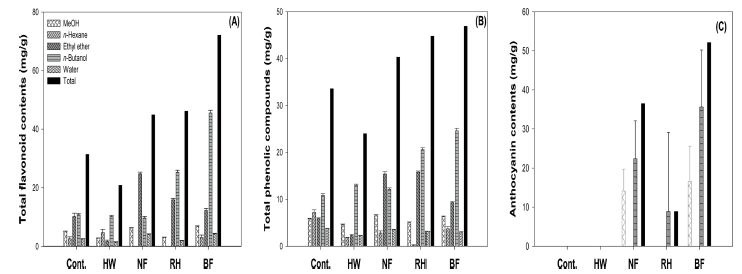
Total flavonoid (A), phenolic compounds (B) and anthocyanin (C) contents in various fractions from 80% MeOH extract of Deodeok (Codonopsis lanceolata).Cont.; Control, non-treatment, HW; Hand weeding, NF; Non-woven fabric, RH; Rice husk, BF; Biodegradable film. Data represent of the values of mean (n = 3) with standard error. Total represents the whole sum of extraction solvents.
이상의 결과를 보면 세 가지 항산화 물질 함량 모두 생분해 성 필름 처리에서 많이 함유되어 있는 것으로 나타났는데, 이 것은 생분해성 필름 처리가 지온을 많이 상승시킴으로 인해 더덕이 생육하는 과정에서 스트레스를 받아 항산화 물질 함량 이 증가한 것으로 보여 진다. 외부 스트레스에 의한 항산화물 질 증가와 관련된 연구는 스트레스의 방어기작으로 항산화물 질이 증가시키거나 (Dixon and Palva 1995;Choi et al., 2013b), 산화스트레스에 대응하기 위해 대사과정을 변화시킴 으로써 항산화물질이 증가한다는 보고가 주를 이루고 있다 (Kim and Hyun, 2011). 특히 고온 스트레스와 관련된 연구는 Lee 등 (2015)이 비트와 쌈추에서 온도 변화에 따라 총 페놀 함량과 플라보노이드 함량이 변화한다고 하였고, Hwang 등 (2014)은 인삼의 경우 수확 후 고온처리에 의해 gensenoside의 함량과 항산화활성이 증가한다고 하여 외부 스트레스와 항산 화 물질과 관련이 있음을 알 수 있었다. 그러나 더덕의 고온 에 의한 적정 스트레스 범위와 항산화 물질과의 관계는 더 깊 은 연구가 필요할 것으로 판단된다.
4. 항산화 활성
피복물 처리에 따른 더덕 MeOH 추출물 및 용매 분획물의 DPPH, ABTS radical 소거활성을 분석한 결과 (Fig. 6), DPPH radical 소거활성 (Fig. 6A)은 피복물 처리보다는 무피 복 처리에서 다소 활성이 높은 경향이었다. 용매 분획별로는 피복물 처리에 상관없이 항산화 물질의 함량이 가장 많았던 n-butanol층에서는 활성이 낮았고, 반면에 항산화 물질 함량이 적 었던 water, ethyl ether층에서 오히려 높은 활성을 나타내었다.
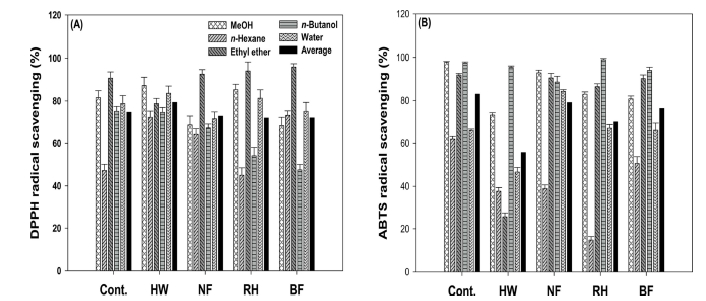
DPPH (A) and ABTS (B) radical scavenging activities in various fractions from 80% MeOH extract of Deodeok (Codonopsis lanceolata).Cont.; Control, non-treatment, HW; Hand weeding, NF; Non-woven fabric, RH; Rice husk, BF; Biodegradable film. Data represent of the values of mean (n = 3) with standard error. Average represents the mean value of total extraction solvents.
이것은 water 층에는 주로 극성이 높은 탄닌, 당, 단백질, 염류 등이, 에테르 층에서는 알칼로이드, 배당체, 수지, 식물색 소, 탄닌 등 (Kang et al., 2007)이 주로 용출되기 때문에 피 복물처리에 의해 이들의 함량이 높아진 것으로 판단된다.
ABTS radical 소거활성 (Fig. 6B)도 무처리에서 가장 높은 경향이고 손제초, 부직포, 생분해, 왕겨 처리 순이였다. 용매분 획별로는 DPPH radical 소거활성과는 달리 항산화물질 함량 이 높았던 n-butanol층에서 모든 처리에서 활성이 높았고, 그 다음으로 ethyl ether, MeOH 추출물, water, n-hexane층 순이 였다. 따라서 DPPH와 ABTS radical 소거활성은 피복물 처리 간에 항산화물질 함량과는 달리 뚜렷한 경향을 찾을 수가 없 었다. 이것은 Wang 등 (1998)의 보고에 따르면 폴리페놀의 종류에 따라 ABTS radical은 제거하지만 DPPH radical은 소 거하지 못하는 경우가 있으므로 두 측정법 간에 반대의 결과 가 도출될 수가 있다고 하여, DPPH, ABTS radical 소거활 성간의 차이 또한 항산화 물질 함량보다는 소거활성을 나타 내는 항산화물의 종류에 따른 차이로 인하여 발생한 것으로 판단된다. 이것은 플라보노이드류, 페놀화합물과 안토시아닌류 는 한 가지 물질이 아닌 여러 가지의 물질들의 총칭 (Dai and Mumper, 2010)이므로 각각의 물질이 DPPH와 ABTS활 성에 영향을 미친 것으로 판단되기 때문에 이들 생리활성물질 에 대한 연구는 좀 더 필요할 것으로 판단된다.
따라서 피복물 처리 중 생분해성 필름이나 검정 부직포 처 리는 더덕의 생육을 촉진시킬 뿐만 아니라 지하부의 환경의 변화를 주어 항산화 물질인 페놀, 플라보노이드, 안토시아닌의 함량을 증대시키는 것으로 나타났다. 더불어 이러한 물질 외 다른 항산화 물질의 변화를 유도하여 항산화 활성에도 영향을 미치는 것으로 판단된다.
감사의 글
본 연구는 농촌진흥청 공동연구사업(과제번호: PJ0109302016) 의 연구비 지원에 의해 이루어진 결과로 이에 감사드립니다.
References
-
Arnous, A, Makris, DP, Kefalas, P, (2001), Effect of principal polyphenolic components in relation to antioxidant characteristics of aged red wines, Journal of Agricultural and Food Chemistry, 49, p5736-5742, 11743756.
[https://doi.org/10.1021/jf010827s]

-
Brand-Williams, B, Cuvelier, ME, Berset, C, (1995), Use of a free radical method to evaluate antioxidant activity, LWT-Food Science and Technology, 28, p25-30.
[https://doi.org/10.1016/S0023-6438(95)80008-5]

- Cho, YD, Kim, SJ, Park, JK, Yang, SC, Kim, YC, Jung, MH, (2008), Effect of soil mulch culture on the growth ofAcorus gramineusin Jeju, Korean Journal of Medicinal Crop Science, 16, supplement 1p93-94.
-
Choi, HG, Kwon, JK, Moon, BY, Kang, NJ, Park, KS, Choi, MW, Kim, YC, (2013), a Effect of different light emitting diode(LED) lights on the growth characteristics and the phytochemical production of strawberry fruits during cultivation, Korean Journal of Horticultural Science and Technology, 31, p56-64.
[https://doi.org/10.7235/hort.2013.12100]

- Choi, MY, Oh, HS, Kim, JH, (2006), Changes of physicochemical properties of cultivatedCodonopsis lanceolatastored at various storage conditions, Korean Journal of Plant Resources, 19, p59-67.
- Choi, SC, Kim, JG, Choo, YS, (2013), b Effects of salt stress on inorganic ions and glycine betaine contents in leaves ofBeta vulgarisvar.ciclaL, Korean Journal of Ecology and Environment, 46, p388-394.
-
Choung, MG, Sohn, EH, (2011), Anti-tumor activity of saponin fraction ofPlatycodon gradiflourmthough immunomodulatory effects associated with NO production in RAW 264.7 cells, Korean Journal of Plant Resources, 24, p557-563.
[https://doi.org/10.7732/kjpr.2011.24.5.557]

- Chung, MS, (1999), Compositions and color ofCodonopsis lanceolataaffected by cultivation methods, The Journal ofKorean Society of Food and Cookery Science, 14, p529-534.
-
Dai, J, Mumper, RJ, (2010), Plant phenolics: Extraction, analysis and there antioxidant and anticancer properties, Molecules, 15, p7313-7352, 20966876.
[https://doi.org/10.3390/molecules15107313]

-
Dixon, RA, Palva, NL, (1995), Stress-induced phenylpropanoid metabolism, The Plant Cell, 7, p1085-1097, 12242399.
[https://doi.org/10.1105/tpc.7.7.1085]

-
Hwang, CR, Lee, SH, Jang, GY, Hwang, IG, Kim, HY, Woo, KS, Lee, JS, Jeong, HS, (2014), Changes in ginsenoside compositions and antioxidant activities of hydroponic-cultured ginseng roots and leaves with heating temperature, Journal of Ginseng Research, 38, p180-186, 25378992.
[https://doi.org/10.1016/j.jgr.2014.02.002]

-
Ichikawa, M, Ohta, S, Komoto, N, Ushijima, M, Kodera, Y, Hayama, M, Shirota, O, Sekita, S, Kuroyanagi, M, (2009), Simultaneous determination of seven saponins in the roots ofCodonopsis lanceolataby liquid chromatography-mass spectrometry, Journal of Natural Medicines, 63, p52-57, 18841442.
[https://doi.org/10.1007/s11418-008-0294-4]

-
Jeon, SM, Kim, SY, Kim, IH, Go, JS, Kim, HR, Jeong, JY, Lee, HY, Park, DS, (2013), Antioxidant activities of processed Deoduck(Codonopsis lanceolata) extracts, Journal of the Korean Society of Food Science and Nutrition, 42, p924-932.
[https://doi.org/10.3746/jkfn.2013.42.6.924]

-
Jeong, JH, Jung, H, Lee, SR, Lee, HJ, Hwang, KT, Kim, TY, (2010), Anti-oxidant, anti-proliferative and anti-inflammatory activities of the extracts from black raspberry fruits and wine, Food Chemistry, 123, p338-344.
[https://doi.org/10.1016/j.foodchem.2010.04.040]

-
Joh, EH, Lee, IA, Han, SJ, Chae, SJ, Kim, DH, (2010), Lancemaside A ameliorates colitis by inhibiting NF-κB activation in TNBS-induced colitis mice, International Journal of Colorectal Disease, 25, p545-551, 19956958.
[https://doi.org/10.1007/s00384-009-0858-0]

- Jung, DC, Oh, JM, Lim, HC, Song, YJ, Kim, JM, (2011), Effect of soil mulching materials and methodson weed occurring for the growth and flowering inGypsophila paniculatacultivation, Korean Association for Flower Industry Development, 19, p15-21.
-
Jung, IH, Jang, SE, Joh, EH, Chung, J, Han, MJ, Kim, DH, (2012), Lancemaside A isolated fromCodonopsis lanceolataand its metabolite echinocystic acid ameliorate scopolamineinduced memory and learning deficits in mice, Phytomedicine, 20, p84-92, 23079229.
[https://doi.org/10.1016/j.phymed.2012.09.005]

- Kang, SH, Park, SK, Lee, YA, Oh, HK, Choi, HU, Hwang, KJ, (2007), Natural substance extract and separation analysis. Freeacademy.Paju, Korea, p25.
-
Kim, EJ, Yang, WS, Park, JG, Kim, HG, Ko, JY, Hong, YD, Rho, HS, Shin, SS, Sung, GH, Cho, JY, (2014a), Lancemaside A fromCodonopsis lanceolatamodulates the inflammatory responses mediated by monocytes and macrophages, Mediators of Inflammation, (cited by 2016 Jan 14).
[https://doi.org/10.1155/2014/405158]

-
Kim, JA, Moon, HK, Choi, YE, (2014), b Triterpenoid saponin contents of the leaf, stem, and root ofCodonopsis lanceolata, Korean Journal of Medicinal Crop Science, 22, p1-7.
[https://doi.org/10.7783/KJMCS.2014.22.1.1]

- Kim, JH, Chung, MH, (1975), Pharmacognostical studies onCodonopsis lanceolata., Korean Journal of Pharmacognosy, 6, p43-47.
- Kim, JS, Hyun, TK, (2011), Effect of NaCl stress on the growth, antioxidant materials, and inorganic ion content in head lettuce seedlings, Korean Journal of Horticultural Science and Technology, 29, p433-440.
- Kim, SS, Jeong, MH, Seo, YC, Kim, JS, Kim, NS, Woon, WB, Ahn, JH, Hwang, B, Park, DS, Park, SJ, Lee, HY, (2010), Comparison of antioxidant activities by high pressure extraction ofCodonopsis lanceolatafrom different production areas, Korean Journal of Medicinal Crop Science, 18, p248-254.
- Kim, SY, Lee, SS, Choi, HS, Sohn, HR, Hur, BK, Oh, SM, (2007), Effect of mulching materials on bolting and growth inAngelica koreanaMax, Korean Journal of Plant Resources, 20, p331-335.
- Kim, YC, Koh, EK, Lee, H, Kim, JH, Oh, HC, Jeon, JY, Kim, MH, Choi, MK, (2003), Guideline of extraction process for compound groups from natural products and validation of crude drug preparations using the typical standard compounds, Ministry of Food and Drug Safety, Cheongju, Korea, p1-220.
-
Lee, KT, Choi, J, Jung, WT, Nam, JH, Jung, HJ, Park, HJ, (2002), Structure of a new echinocystic acid bisdesmoside isolated fromCodonopsis lanceolata.roots and the cytotoxicactivity of prosapogenins, Journal of Agricultural and Food Chemistry, 50, p4190-4193, 12105944.
[https://doi.org/10.1021/jf011647l]

- Lee, NH, (2014), Natural products chemistry, Shinilbooks, Seoul, Korea, p19.
-
Lee, SG, Choi, CS, Lee, HJ, Jang, YA, Lee, JG, (2015), Effect of air temperature on growth and phytochemical content of Beet and Ssamchoo, Korean Journal of Horticultural Scienceand Technology, 33, p303-308.
[https://doi.org/10.7235/hort.2015.14061]

- Lee, SP, Kim, SK, Choi, BS, Lee, SC, Yeo, SK, (1998), Effect of organic matter applications on general components andessential oils inCodonopsis lanceolataTrautv., Korean Journal of Medicinal Crop Science, 6, p21-27.
- Lee, SP, Kim, SK, Nam, MS, Choi, BS, Lee, SC, (1996), Effect of shading and organic matter applications on growth and aromatic constituents ofCodonopsis lanceolata, Korean Journal of Crop Science, 41, p496-504.
- Ministry of Agriculture, Food and Rural Affairs(MAFRA), (2015).
- Oh, HS, Choi, MY, Kim, JH, (2005), Changes of the content of crude saponin and codonoside of cultivatedCodonopsis lanceolatastored at various storage conditions, Korean Journal of Plant Resource, 18, Supplement 1p149-150.
- Park, EA, (2014), Physicochemical characteristics and antioxidant activities ofCodonopsis lanceolataleaves, The Korean Journal of Culinary Research, 20, p183-192.
- Park, JM, Kang, JH, Jeong, EH, Song, GW, (2004), Growth and yield ofAtractylodes japonicaKoidz. affected by mulching methods, Korean Journal of Medicinal Crop Science, 12, p226-230.
-
Park, SJ, Seong, DH, Park, DS, Kim, SS, Gou, JG, Ahn, JH, Yoon, WB, Lee, HY, (2009), Chemical compositions of fermentedCodonopsis lanceolata, Journal of the Korean Society of Food Science and Nutrition, 38, p396-400.
[https://doi.org/10.3746/jkfn.2009.38.3.396]

- Seo, CS, Hwang, DS, Lee, JK, Ha, HK, Chun, JM, Um, YR, Jang, S, Shin, HK, (2009), Concentration of heavy metals, residual pesticides and sulfur dioxide of before/after a decoction: In prescription of digestive system, The Korea Journal of Herbology, 24, p111-119.
-
Shen, Y, Jin, L, Xiao, P, Lu, Y, Bao, J, (2009), Total phenolics, flavonoids, antioxidant capacity in rice grain and their relations to grain color, size and weight, Journal of Cereal Science, 49, p106-111.
[https://doi.org/10.1016/j.jcs.2008.07.010]

-
Wang, MF, Li, JG, Rangarajan, M, Shao, Y, LaVoie, EJ, Huang, TC, Ho, CT, (1998), Antioxidative phenolic compoundsfrom sage(Salvia officinalis), Journal of Agricultural and Food Chemistry, 46, p4869-4873.
[https://doi.org/10.1021/jf980614b]

- Yoo, HH, Baek, SH, Park, YK, Lee, SH, Kim, CM, Lee, KS, Park, MK, Park, JH, (2002), Quality control of dried roots of Codonopsis lanceolata, Korean Journal of Pharmacognosy, 33, p85-87.
